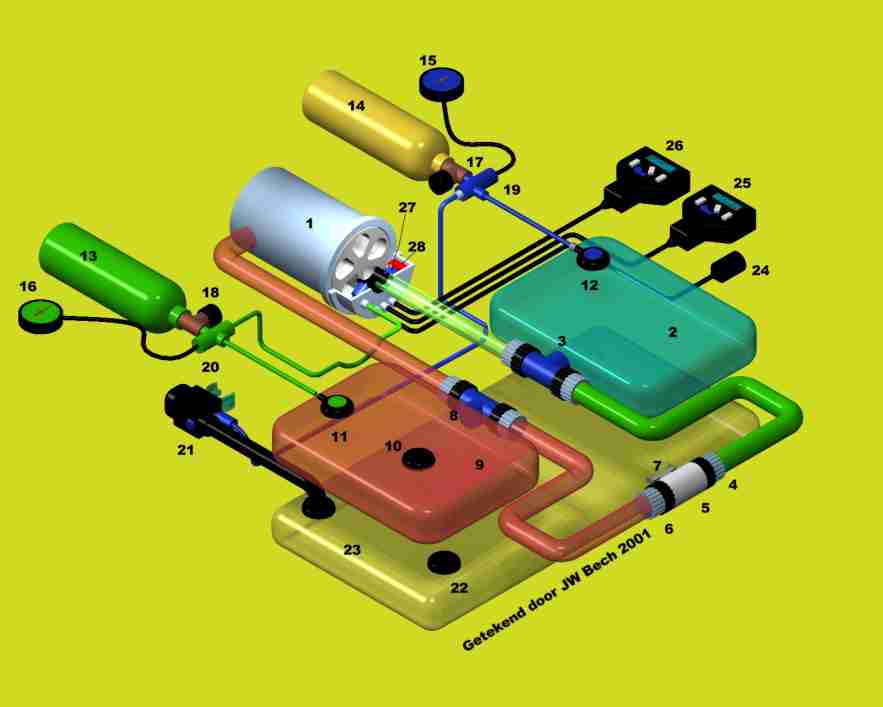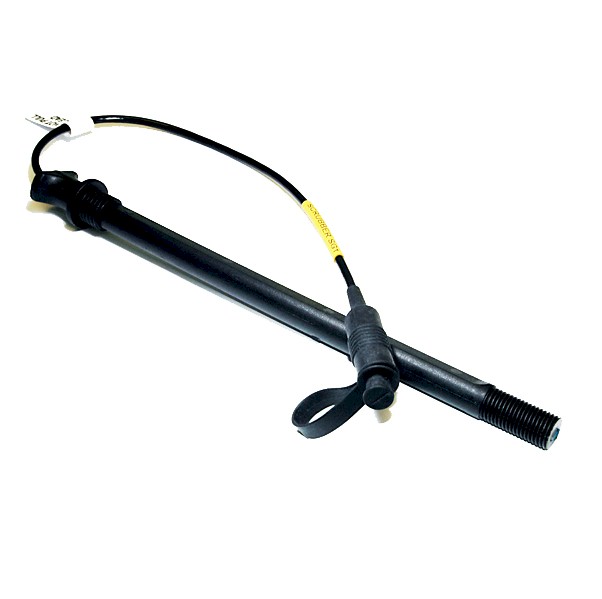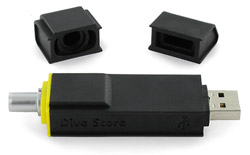 |
-
1.Scrubber
-
2.Counter lung (inhale)
-
3.Water trap
-
4.Inhale valve
-
5.Mouthpiece assembly (open/close)
-
6.Exhale valve
-
7.Mouthpiece
-
8.Water trap
-
9.Counter lung (exhale)
-
10.Over pressure valve
-
11.Oxygen inflator
-
12.Diluent inflator
-
13.Oxygen cylinder
-
14.Diluent cylinder
- 15.Diluent gauge
- 16.Oxygen gauge
- 17.Diluent valve
-
18.Oxygen valve
-
19.First stage for reducing HP diluent
-
20.First stage for reducing HP oxygen
-
21.Inflator / regulator
-
22. Over
pressure valve Wing
-
23.Wing
-
24.Buzzer
-
25.Master/Slave controller
-
26.Master/Slave controller
-
27.Oxygen cells
-
28.Solenoid
|
-
The breathing loop of the CCR and the breathing
loops of the SCR and the O2 rebreather all share the same
parts:
-
mouthpiece assembly, in- and exhale valves, hoses
for gas supply and gas removal and scrubber. Both at the inhale and at
the exhale side a counter lung is fitted. In the scrubber lid of the
closed circuit rebreather there are 3 oxygen cells placed, for measuring
the oxygen level after the CO2 has been removed from the gas.
The controller regulates the solenoid (looks like an electronic valve)
that injects oxygen until the set point is reached. The diver can adjust
the gas volume in the loop by manual* diluent injection. The volume in
the loop and the counter lungs decreases as soon as the diver descents
by the increasing water pressure. In some rebreathers this process can
be regulated by a computer (Cis Lunar MK5) or by adding an ADV
(Automatic Diluent addition Valve); on every depth the loop volume will
be sufficient and the set point can be maintained by keeping the oxygen
level regulated by the controller. During the dive the mouthpiece cannot
be taken out because the loop will be flooded by water and the system
will no longer be able to function properly. In case the mouthpiece is
dropped by accident, most off the water will be trapped by the water
traps near the counter lungs. The picture shows the Inspiration from
Ambient Pressure Diving. Other CCR rebreathers may show some differences
in operation or parts. Thatís why the CCR rebreather diver training is
apparatus specific.
*In the standard model of the Inspiration rebreather this needs to be
done manually. Most Inspiration divers install such a device themselves,
but an ADV can be fitted by the factory as an option. The ADV is in fact
a second stage placed on the inhale counter lung. In case of under
pressure in the loop the ADV will supply gas from the diluent cylinder,
so the diver can inhale with comfort. It will be clear that most of the
time this will happen during the descent because the gas volume
decreases when the pressure increases.
|
New developments:
|
|
Modern CC rebreathers offer real time
decompression. Real time decompression means that the system is
equipped with a computer that measures the oxygen content and
thus knows the nitrogen content to calculate decompression
obligations. Also Trimix version can be uses since the content
of the makeup gas (diluent) can be programmed into the computer.
Decompression is calculated with several algorithm like
Buhlmann, VPM or RGBM for example. Alarms can be programmed and
several user options are available. Real time decompression has
the big advantage that the rebreather controls the setpoint by
measuring the oxygen. It is the best way to calculate
decompression with the same oxygen cells.
|
 |
|
Head up displays (HUD) are more and more
popular. Beware that a HUD is an additional device for the diver
to have visual control over the rebreather status. It is not a
primary source for knowing the pO2!
|
 |
|
One of the major dangers of the rebreather is
the risk of Hyperoxia. Now in 2010 there is not a reliable CO2
detection system that offers the diver early information that
high CO2 levels are to be expected. The only reliable system on
the market today (may 2010) is the temp-stick technology. In the
scrubber there is a sensor with several heat detecting sensors
mounted linear in the heart of the scrubber. Software measures
the heat development of the chemical reaction and is able to
show and predict the remaining scrubbertime.
|
 |
|
Rebreathers used in the EU should have CE
marking and be build conform EN 14143:2003. A new version will
be released the next few years.
|
 |
|
CC rebreathers might be equipped with Bail Out
Valves (BOV). These BOV's offer the diver a fast way to switch
to open circuit.
|
 |
|
The latest generation of CC rebreather also have
a "black box". This technology offers the diver a way to log his
dives, and the factory to read out data in case of an accident.
|
 |
|
|
| |
|
|
|
|







